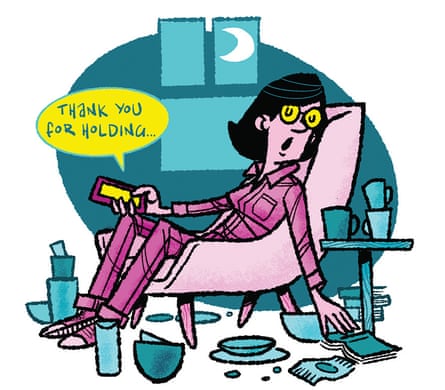Did your flight get cancelled in the school holidays? Has the delivery of your new sofa been delayed? Was your last meal out disappointing? Are your new socks see-through? Are you reading this while you are on hold to customer services? Does everything feel just a little bit worse?
The cost of living crisis has given British households a crash course in the misery caused by inflation, which is scaling heights not seen since the 1980s. But what if there is also another force at work in the economy, lurking in the background and making a bad situation that little bit grimmer?
Welcome to “skimpflation” – a term popularised in the US and gaining traction in the UK. “Skimpflation is when consumers are getting less for their money,” says Alan Cole, a writer at Full Stack Economics and formerly a senior economist at the joint economic committee of the US Congress. “Unlike typical inflation, where they’re paying more for the same goods, skimpflation is when they’re paying the same for something that worsened in quality.”
The most common example is “having to wait longer for things”, says Cole. “If you’ve ordered furniture or an appliance recently, you’ll find that delivery times are slow. That loss of timeliness is a quality downgrade.”
Thanks to the current crisis, we are all familiar with what inflation means: the price of stuff is going up, sometimes by an eye-watering amount. There have also been plenty of examples of shrinkflation, which is when a company reduces the size of a packet of chocolate or crisps, for instance, but the price stays the same.
But even if it is not as easy to identify, when you start to look for skimpflation, you can see it everywhere. It is in the supermarket, when you bump into someone filling shelves because costlier night-shift work has been axed, or when your favourite brand is no longer there because the range has been reduced to cut warehouse costs.
It is in disappointing new clothes that bobble after one wear, or when you book a holiday only to have your flight rescheduled, or find you now have to pay for your food and drink on board. Then, when you try to get your money back or complain, you find the only route is via a web chat with an entity that may or may not be human.
 View image in fullscreen Illustration: Nick Moffatt/The Guardian
View image in fullscreen Illustration: Nick Moffatt/The Guardian
The Planet Money podcast made by US radio producer NPR came up with the term in 2021. It is a “stealth-ninja kind of inflation”, it said, where consumers “pay the same or more for services but they kinda suck compared with what they used to be”. It used the example of the Magic Kingdom, where visitors were walking nearly a mile to get into Disney World and Disneyland because the tram service from the car park was not running.
To be fair, with the impact of the pandemic and the economy teetering on the edge of recession, this is a difficult time for businesses as well as consumers. For every big corporation with deep pockets like Disney, there is a small company struggling to survive. They got through Covid only to be hit by soaring energy and materials prices, plus staff shortages, when the world got back to normal. As customers struggle with rising living costs, firms must choose between passing on their increased expenses, taking a hit to profits (if they are making any), or replacing parts or services with something cheaper.
“I always assumed that was the [high-street] model with socks,” says David Blanchflower, professor of economics at Dartmouth college, and a former member of the Bank of England’s monetary policy committee, when asked about the idea. “I remember it from many years ago: the price of socks remained the same and, as costs changed, the thickness of the sock changed. I don’t know how big a deal it [skimpflation] is … I’d ask a different question: to what extent does inflation measure things properly?”
For most of his economics career, Cole believed that official statistics made inflation seem worse than it really was because it was so hard for the data to capture improvements in the quality of products. Now he thinks the official statistics are failing to show how bad inflation actually is.
He argues that skimpflation becomes more prevalent when it’s hard to produce things or the world is getting poorer. “Usually, the world is getting richer, so you see goods and services getting fancier. But the Covid-19 pandemic made us poorer and less productive in many ways, forcing cutbacks.”
It is also more prevalent in a “seller’s market”, like today, he says. “That’s an environment where more money is moving about the economy, and there are many willing buyers for scarce goods and services. Contrast this with a 2008-2011-style economy, where buyers with cash seem to have the upper hand in transactions, and sellers or workers seem to have little bargaining power. In 2008-2011, money was much less plentiful, and the whole world was a ‘buyer’s market’, if you could afford to be a buyer.
“If the amount of money moving around is higher, but production hasn’t increased, then it stands to reason you’ll get less for your money. Some firms do this by charging you more, but others do this by skimping on their product a bit.”
All producers are looking at ingredients and thinking: Can we use something cheaper to do the same job?Jason Bull
Due to high energy costs and other issues, food costs were already climbing before the war in Ukraine. This inflation has to be paid for, says Jason Bull of West Yorkshire-based ingredients firm Eurostar Commodities, who says companies are trying to find cheaper recipes. “All producers are looking at ingredients and thinking: ‘Can we use something cheaper to do the same job – a different flour, or a different starch, to mitigate the rising costs of ingredients and freight,’” he says.
Changing the recipe may mean the price won’t change but Bull says the quality and taste can. “Food producers want to give the people the ability to afford a healthy and varied diet. However, there’s a real risk people will be eating less nutritious food.”
His view is echoed by Andrew Selley, chief executive of Bidfood, a large UK food wholesaler, who last month warned that soaring food costs meant “difficult decisions for school caterers”. “Either they are going to serve smaller portions or use cheaper ingredients, which isn’t going to be good for the children.”
Higher food prices are a massive headache in the hospitality trade, too, with restaurants forced to resort to “menu engineering” (the technical term for using cheaper ingredients) to make the maths work for each dish. This happens all the time but is particularly relevant now due to “crazy” price rises, says the restaurant industry consultant Peter Backman.
 View image in fullscreen Illustration: Nick Moffatt/The Guardian
View image in fullscreen Illustration: Nick Moffatt/The Guardian
In tough times, a common trick is to cut food sold in slices more thinly and at an angle so it covers more of the plate, or to reduce the amount of pricey meat and fish while introducing more pulses and vegetables, which are cheaper. But Backman says there is “only so much beef you can replace with lentils before the customer says: ‘I ordered beef and not lentils.’”
Where clothes are concerned, experts report that retailers are offsetting higher costs by buying lower-quality fabric or manufacturing them more cheaply. “The wash-and-wear performance of fabrics that look similar on the hanger can vary a lot,” says Matthew Easter, who runs school uniform brand Trutex, which competes with ultra-cheap supermarket ranges that he says are made of less hard-wearing fabrics.
That Britons feel shortchanged is apparent in the snapshot of sentiment provided by the Customer Satisfaction Index, published by the Institute of Customer Service (ICS). Its most recent update showed customer service complaints at a record high, with the quality, reliability and availability of goods and services the main bugbears.
“The number of customers experiencing a problem with an organisation is at its highest ever level,” says the ICS’s chief executive, Jo Causon. “When things go wrong, they can go very wrong indeed, causing frustration and distress, especially in the context of significant life events, or for customers who are vulnerable or who are less confident about engaging through digital channels.”
The survey, which polls 10,000 consumers, found 16% of customers had experienced a problem with a brand’s service in the past six months. There were fewer complaints about staff but far more about quality issues or items being out of stock.
Skimpflation is a new idea but Cole suggests that economists should pay some attention to it. “If you see a firm cutting back product quality for the same price, that’s a good indication that we are in a ‘you get less for your money’ regime, where sellers have the power,” he says.
As for the customers, there’s an old saying that springs to mind: let the buyer beware.



